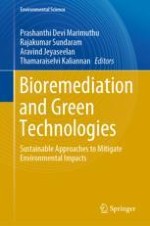2021 | Book
Bioremediation and Green Technologies
Sustainable Approaches to Mitigate Environmental Impacts
Editors: Prof. Dr. h. c. Prashanthi Devi Marimuthu, Prof. Dr. h. c. Rajakumar Sundaram, Prof. Aravind Jeyaseelan, Prof. Dr. h. c. Thamaraiselvi Kaliannan
Publisher: Springer International Publishing
Book Series : Environmental Science and Engineering
